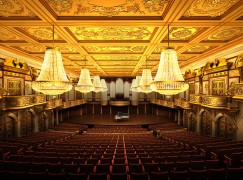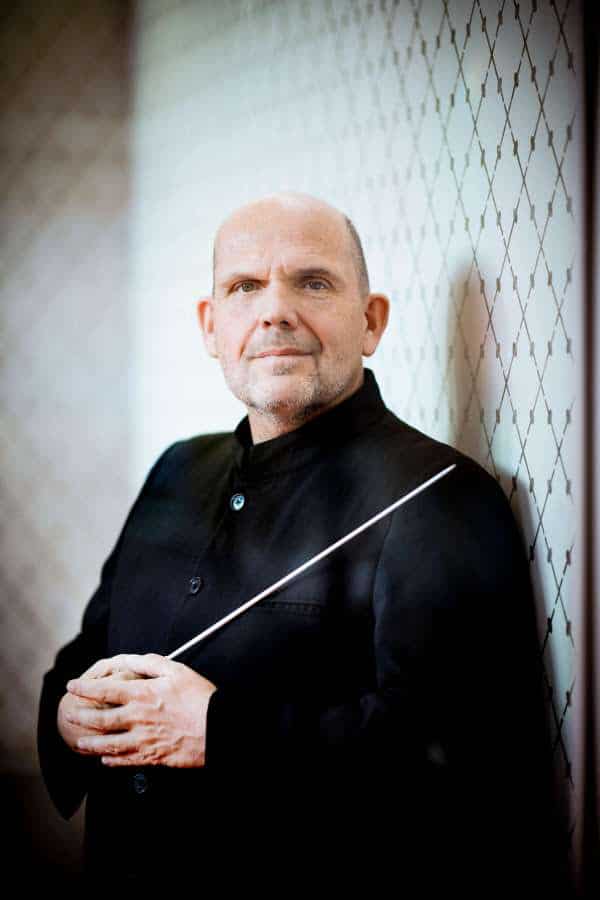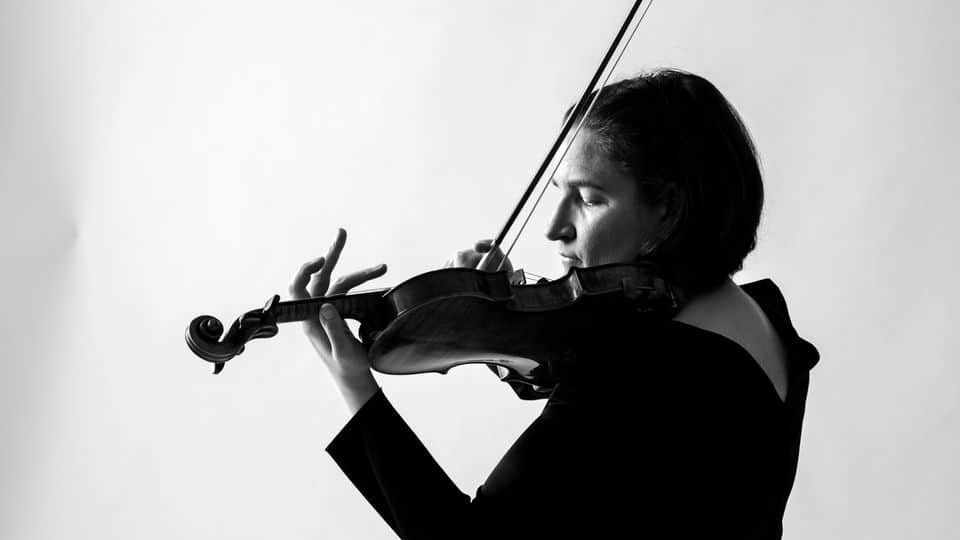Why do we love some halls and hate others? An acoustician explains
mainNicholas Edwards, an acoustician who helped restore Birmingham’s Town Hall, explains why the Musikvereinsaal in Vienna is everyone’s ideal and Birmingham’s comparable shoebox was not.
Watch.

Why are some concert halls acoustically loved by audiences and others are not? from Idibri on Vimeo.





Fail. It takes two seconds looking at the floor plans to understand why the premise that these two 19th century halls are quite similar but sound very different is flawed. Because they are constructed very differently inside.
Very interesting. But it leaves a couple of questions open, like what is the difference in hearing between listeners on the groundfloor level and on the balconies in the Musikvereinsaal? It seems probable that the main factor in acoustical quality is the very rich and detailed ornamentation which spreads the sound, and the relatively small size of the hall which keeps the vibrations together, ‘compact’. The Concertgebouw in Amsterdam has beautifully coloured sound, but is a bit too large to keep the sound ‘compact’, the players of the orchestra have often some difficulty in hearing the players at the other end of the orchestra directly and clearly, which makes ensemble playing more difficult. As far as I know, the Musikvereinsaal does not have that problem, and the podium is much smaller.
The futuristic design at the end of the video looks really awful. Such architects would go to incredible scientific length to achieve a result, similar to the Musikvereinshoebox, but with the avoidance of its architectural style and simple basic structure. It is like trying to find a technological way of walking but without your own legs…. demonstrating the invalid thinking of architectural modernism.
In Nashville they thought it better to follow the Musikverein example with the Schermerhorn Symphony Hall, and successfully achieved what futurism can only achieve – if at all – in a roundabout, forced, and utterly ugly way. The fear of traditionalism in modern architecture is a mental problem…. In Germany, a discussion is bubbling-up about reconstructing the town centers which were destroyed in WW II and filled with modernist monstruosities; the preference is now to restore them in their old glory and character. The Berlin city castle (the 17C royal palace) is being reconstructed, giving the city its heart back. In England, Poundbury demonstrates a human modern settlement in an old style, supported by Prince Charles, and it is hughely popular. Utopianism is a 20C disease, and by now entirely outdated and conventional.
That futuristic design at the end looks vaguely like Suntory Hall in Tokyo which I believe celebrates its 30th anniversary this year. It certainly has excellent acoustics.
Like the Musikvereinsaal the Takemitsu Hall in Tokyo Opera City is narrow and high with splendid acoustics and a reverberation time of nearly 2 seconds when full – yet the first balcony tier seems quite low compared to Vienna. On the other hand the balcony in the equally superb acoustics of the considerably smaller Kirkegaard-designed Petronas Hall in Kuala Lumpur seem higher – and yet the reverberation time in the hall itself is nearer 1.8 seconds.
It does seem that the video must be just a part of a much more comprehensive analysis, for it mentions neither reverberation time, quality of sound nor the effect of reflections from behind the orchestra and the back of the auditorium. Or indeed, as John Borstlap points out, the difference in sound quality between stalls and tiers.
A new floor plan that would both sound good and get the cheap seats closer to the stage would be welcome.
The hall the Dallas Symphony plays in has chambers near the ceiling that can be opened to provide longer reverb time so maybe that element is not so dependent on visible geometry anymore.
These louvres opening up chambers in the ceiling are far from new and are incorporated in many halls. The Hong Kong Cultural Centre Concert Hall (opened 1989) includes them, ostensibly to cut down reverberation time to make the venue more suitable for chamber music. In that hall they just do not work and are a waste of time. But then the sooner that venue is torn down the better as not much of it “works”!
They are certainly newer than the Musikvereinsaal.
They don’t work in Hong Kong? Too bad.
They do work in Dallas (also 1989) so there may be more at fault in Hong Kong than the doors.
Since you are in the know… what was the first hall to incorporate these optional chambers?
Sorry I have no idea when they first appeared. I do know that the acoustician Prof. Harold Marshall used them in the design of the Christchurch Town Hall which opened in 1972 and which was listed in last year’s Guardian as one of ten best concert halls in the world! Ironically the same Prof. Marshall was engaged by Hong Kong which ended up so badly.
I have never been to Dallas but it does seem from photos that it is basically a shoe-box shape. Hong Kong’s shape is an oval with a kink and squeezes in too many people for its volume! How anyone could possibly believe that kind of basic shape could work acoustically is, well, unbelievable!
The Birmingham Town Hall opened in 1834 and the hall in Vienna in 1870. Although there is a vast improvement in Birmingham having removed the upper gallery (Edwardian insert), it is impossible to make an old listed building perfect, acoustically.
Don’t forget though that when the Town Hall reopened, the Times stated that Birmingham now had two concert halls better than what they had in London (excluding Wigmore Hall which is too small for orchestral concerts).
Having sung in the old Town Hall and listened to over 700 concerts there, I can confirm that the sound is far better sitting upstairs than on the ground floor.
While visiting from Canada in February I managed to get seats for a concert at the Wigmore Hall. Mahan Esfahani was one of three musicians playing.
I was bowled over by the experience. Not just with Esfahani’s amazing playing and introduction, but the ambience, acoustics, lighting, architecture, cupola, along with the unpretentious audience provided a whole package that could not have been a more fitting environment for the three musicians on that rainy night.
Wigmore Hall had been on my bucket list for years, and it more than lived up to my expectations.
My love for the Musikverein has nothing whatsoever to do with acoustics and everything to do with its history; Brahms conducted there, as did Richard Strauss, Mahler and the majority of famous conductors (with fabulous orchestras) over its lifetime. It opened for business in 1871 and those who passed through those doors and stood on that podium are now the stuff of legend.
However, its history has much to do with its acoustics, therefore so is your love for it.
I have to admit the ambience of the place is pretty amazing. The Viennese are also mostly warm and friendly. But the seats are somewhat small and one can feel rather cramped and uncomfortable. The hilarious ritual of a whole row having to stand up when one person leaves or arrives in a row of seats always had me trying to keep a straight face!! Then the tiny little individual 4-legged seats on the Parterre Loge right next to the orchestra involved conjuring tricks I never quite mastered.
Before 1900, people were much smaller, due to an incomprehensive general diet and the local coffee culture (coffee diminishes appetite). It is also the reason why string playing before 1900 was much less in tune: fingers were shorter. Also, mouth pieces of the brass were smaller, to be compatible with mouth size, and trombone slides were shorter – the instruments smaller – as timpani were smaller and sticks lighter. Now I think about it, also composers were smaller: Mozart, Schubert, Brahms, Wagner, Mahler. So, leg room in the Musikverein is in harmony with the hall’s traditions.
” …and trombone slides were shorter… ”
Can you cite this? I’ve never heard anyone knowledgeable about historic trombones claim such a thing.
The basic physics of how long a tube has to be to produce a certain pitch is against you here.
The prevailing standard B-flat tenor trombone has been around for a long time, and in times of lower concert pitch, which would indicate a longer instrument, not a shorter one.
The image used here is not Musikverein… but a newly built small concert hall in Zhuhai, Guangdong, China. http://www.zhuhaiicec.com/en/server/network.html , I know they tried hard to make it looks like Musikverein. You can find my photosphere here: https://goo.gl/maps/Aff4fzauGKD2
Boston Symphony Hall certainly has that Musikvereinsaal wow factor with similar side balcony structures.
And I’d absolutely love to go there for a concert. It may even be older than the actual Musikverein building?
Boston’s Symphony Hall was opened in 1900 and was designed by the famed New York architects McKim Mead and White. The building is in the classic “shoebox” shape and was modeled after the second Gewandhaus in Leipzig, which was destroyed in WW II.
The architects hired Wallace Clement Sabine, then a young assistant professor of physics at Harvard, to consult on sound reverberations. He sure got it right!
Interestingly, Karajan thought the acoustics of Symphony Hall slightly preferable to those of the Musikvereinsaal.